
The MTA is soon facing their own Gordian Knot: the shutdown and rehabilitation of the Canarsie Tubes, the tunnels that carry the L train between Manhattan and Brooklyn. Much has been written and yelled about this project and I must fault the MTA for truly dropping the ball when it comes to handling the PR. The MTA is in a no-win situation. After a decade of unprecedented growth the L train went from a backwater train running through a no-mans-land to becoming the pivotal artery feeding one of the hottest real estate markets in the nation. Mother nature has a way of periodically reminding us that she is, ultimately, in charge and in 2012 Hurricane Sandy battered the city flooding all river tunnels south of 53rd St. The MTA had the difficult job of having to rebuild the tunnels lest the intense corrosion from salt water eat away at everything metal and cripple the subway further. The MTA had more flexibility when it closed down other tunnels (the R was shut down for good for 14 months but due to redundancies the impact was minimal) but they left the L for last because they knew they had no good options.
While some have pointed out that there were in fact two other tunnels planned between Manhattan and Williamsburg it doesn’t really help anything today. The L Train Coalition was recently quoted in a town hall meeting as asking why the MTA does not consider building a new tunnel first and repairing the Canarsie Tubes once the new tunnel is open. I don’t want to sound hypocritical since this basic idea is the basis for quite a number of futureNYCSubway posts on this very site but the reality is that the Federal government is willing to foot the bill for restoration and clean up, not a brand new project. The same thing is going on across town between New York and New Jersey with Amtrak’s North River Tunnel to Penn Station. A new tunnel takes time to plan and the MTA ballparked the cost around $4.5b (which given the length and new stations seems to line up with current 2nd Ave Subway costs). So while long term a new tunnel will be needed it won’t really help us now.
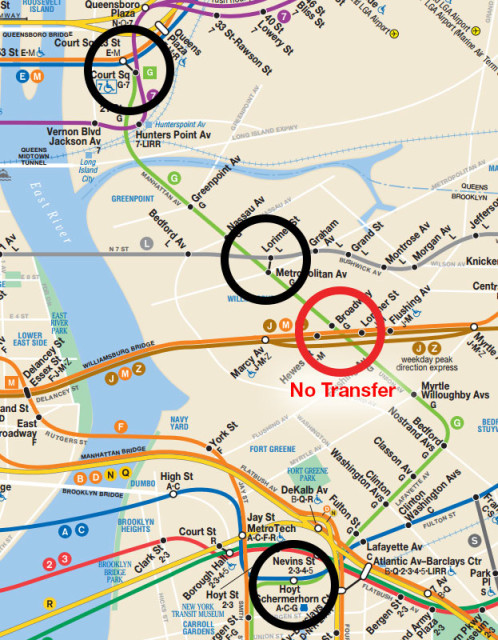
Over the last decade, to their credit, the MTA has undergone rather large scale station expansions at key transfer station where, because of the competing companies, transfers were never offered. These include Bleecker St-Broadway-Lafayette where once only the downtown 6 offered a transfer to the B/D/F/M, Jay St-MetroTech where the R passed over the A/C/F but never transferred, and Court Sq where the E/M, G, and 7 trains meet. The Court Sq transfer was partially built by CitiGroup when their LIC headquarters went up in the early 90s. The MTA even offers an out of system transfer between 59th St-Lexington Ave and Lexington Ave-63rd St which due to the technical limitations of the MetroCard means the MTA loses money (since you can’t prove you made the transfer the fare is waved).
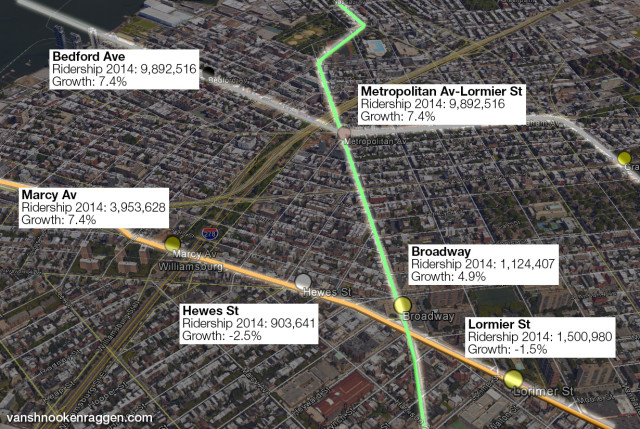
When offered the chance to build either type of transfer at Broadway/Union Ave the MTA balked. By the numbers you can see why: Hewes St only saw 903,000 riders in 2014, Broadway saw 1.1 million, and Lorimer (J/M/Z) saw 1.5 million. Compare this with Court Sq which saw 6.7 million, Jay St-MetroTech which saw 12.2 million, and Bleecker St-Broadway-Lafayette which saw 12.9 millionm. Furthermore the physical connections at these new transfer stations was minimal since each platforms crossed relatively close to one another. Hewes St station is about 750ft from the Broadway station and would involve a large new structure to connect the underground mezzanine to the elevated station (see the picture at the top of the post which shows the new structure at Court Sq). Given the expensive engineering to connect the two stations it’s no wonder the MTA passed.
But that was a decade ago and many things have changed. Even without the L train closure ridership along the G has exploded in this area; Broadway has seen a 4.9% increase in ridership between 2013 and 2014, Flushing Ave 10.9%, and Myrtle-Willoughby a 9.1% increase. Ridership on the J/M/Z between Marcy Ave and Myrtle Ave, meanwhile, has held steady or even dropped slightly meaning that there is excess capacity which could be used to relieve the L train. Metropolitan Ave-Lorimer St station, the only G transfer station saw 5 million riders coming through the turnstiles in 2014 but this doesn’t account for transfers between the L and G. Anyone who rides here knows that a substantial proportion of traffic at Metropolitan Ave is transfers (the MTA does not track transfers so there are no hard numbers available). The need may not have been there a decade ago but it’s plain to see today.
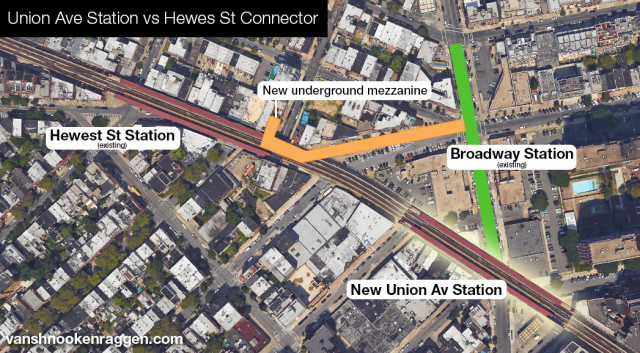
It’s time for the MTA to revisit a connection between the G and J/M/Z. Out of system transfers are confusing for even seasoned riders and limit the effectiveness of the system. The current MTA plan for the L train shutdown involves a free (temporary) transfer between the Lorimer J/M/Z station and Broadway G station. While Hewes St, as the crow flies, is closer to the Broadway station the eastern entrance at Hewes has been closed for years meaning that technically Lorimer has the closest entrance to Broadway. It seems counter-intuitive to go further east and then have to walk back. What I want to see is a brand new elevated station at Union Ave, fully ADA compliant (which would make it only the second elevated J station which would be compliant after Marcy Ave!), and have a direct transfer to the Broadway station below via stairs, escalator, and elevator. The new station would replace both Hewes St and Lorimer St elevated stations as the station spacing is relatively close for modern subways and the ridership levels too low to justify 2 or 3 stations. The new Union Ave station would be 0.4m from Marcy Ave and 0.5m from Flushing Ave, the same distances between many of the G train stations in the area.
This plan isn’t without it’s own issues. Building a new mezzanine to connect to Hewes St might be cheaper but would offer a less friendly transfer and require two sets of elevators along with the need to demolish a nearby building in order to build the connection. A new elevated station could face resistance for casting shadows on the street but it should be noted that the area surrounding this intersection is mostly one story commercial buildings and a police station so the impact would be low. Removal of existing stations will always face resistance from a small percentage of riders who live closest to them and this has been used in the past to oppose station closures. With recent delays in the opening of the 7 train extension and doubts about whether the MTA can deliver the first phase of 2nd Ave by their own December 2016 deadline [this post was written in Feb 2016 and the 2nd Ave Subway was in fact opened on Dec 31, 2016] there are some very real doubts that the MTA could pull this off on time and on budget. These seem like small issues compared with the larger problem of shutting down the L train. What I’m proposing won’t just alleviate the impact of years without the L but it will also set the stage for better transit in all of north Brooklyn. With no transfer the J/Z is a glorified shuttle between Broadway Junction and Chambers St. The M has seen a huge uptick in ridership since being rerouted along 6th Ave. A transfer to the greater subway network in Brooklyn would revolutionize how people get around north Brooklyn and have an immediate impact on reducing congestion at Bedford Ave and Lorimer St. How many L train riders, if given the option, would take a train that bypasses that mess?
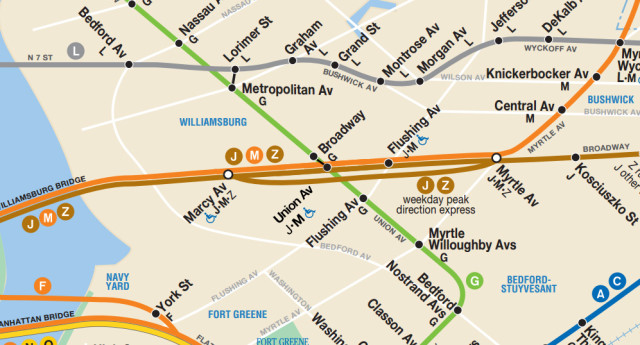
It’s been almost two years since I wrote this post and unfortunately very little has changed. The city and MTA have thrown together a mitigation plan which involves partial bus lanes on the Williamsburg Bridge but not full bus lanes on the approaches (although one route will used the 1st/2nd Ave bus lanes) and a crosstown bus lane on 14th St. Bus lanes are a quick fix and will help somewhat but all one has to do is look at a single rush hour L train and wonder just how many buses are going to be enough to really make a difference. For riders coming from further out the J and M trains will bear the brunt of the traffic and the MTA has been rebuilding the Bushwick Cut, the physical connection between the J and M tracks near Myrtle Ave, so that more M trains can be run. But with all the time the city and MTA have had to think about this problem very little has been done. There is a complete lack of foresight and the MTA is squandering the best crisis they’ve had in generations. Through a quirk of history the G and the J/M/Z have never had a free transfer. The growth of North Brooklyn over the last 20 years has been unprecedented; indeed Williamsburg is a world wide poster child for hip urban living or the evils of gentrification, depending on who you ask. The Broadway elevated, on which the J/M/Z run, was originally built in the 1880s and as the only parallel line to the L train it is in dire need of modernization. Creating a new connection between the two lines is a long term investment that would speed up commutes all over northern Brooklyn by taking away transfers to the L at Metropolitan Av and opening up a faster route to downtown Brooklyn from Bushwick.

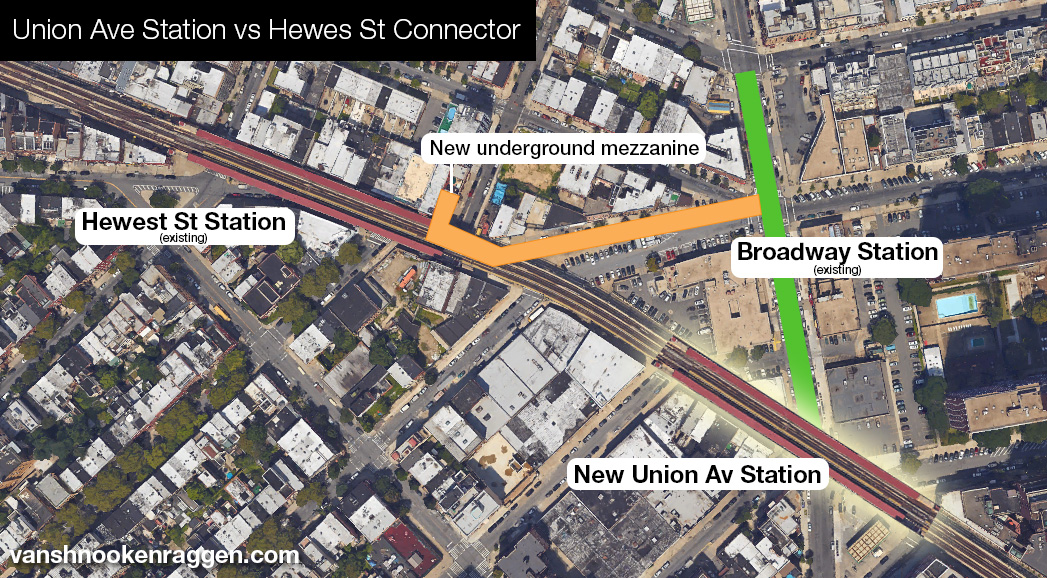

Great post. Cut the knot and make things better rather than just sinking in billions for no better than what we had before.
Some good ideas that for the most part not practicable
First there isn’t enough money in the budget second these projects would take ten or more years to complete and third and most important there are very few people I know who will walk that distance to transfer to another train.
They can always find money if they really want to do it. The Court Sq station complex didn’t take a decade and either option could be built in a few years tops (ok, 5 given that it’s the MTA). But I agree that the walk would turn a lot of people off which is why I prefer the new Union Ave station to the connector.
This really is a great post. I always tell people to do this transfer, but it makes so much sense to just connect it since the demand will go way up after the L shutdown.
It seems that in the recent past the MTA has been more open to permanent service changes after “temporary” ones are instituted for construction projects. I hope that after the Canarsie Tubes are back up and running that the MTA will see first hand the benefit of a G-J/M/Z connection and at least figure out how to keep a free out of system transfer. The physical connection I’m advocating for is a long term solution.
whoa whoa whoa could this actually work?!
http://staging.rethinkstudio.org/l-train-alternative/#prettyPhoto
a quick rejigger of the tracks at Hoyt-Schermerhorn to run 8th Avenue trains up the Crosstown Line would give a direct-to-Manhattan trip for North Brooklyn riders. The proposal is actually…. thrilling (for train dorks like us).
It is a terrible idea. First off youd have to blow up part of Hoyt-Schermerhorn in such a way that all A/C/E trains would have to run shorter. Then there is the Cranberry St Tunnel congestion issue. Then there is the fact that no one would ride the E from Lorimer St all the way downtown to get back up to 14th St when a much simpler and faster way would be to just build a free transfer at Broadway/Hewes St on the J/M/Z.
Yup, underground mezzanine seems like the simplest and easiest to execute right now. Hopefully they’re paying attention.